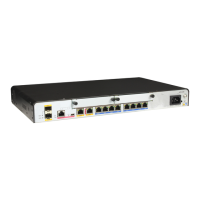Data Preparation
To configure the WLAN radio environment, you need the following data.
No. Data
1 WMM profile name and (optional) WMM profile ID
2 (Optional) WMM EDCA parameters for STAs: arbitration
inter frame spacing number (AIFSN), minimum backoff
time (ECWmin), maximum backoff time (ECWmax), and
transmission opportunity limit (TXOPLimit)
3 (Optional) WMM EDCA parameters for APs: AIFSN,
ECWmin, ECWmax, TXOPLimit, and ACK policy
4 Radio profile name and (optional) radio profile ID
5 AP ID, radio ID, name or ID of the radio profile bound to
the radio
6 (Optional) Radio parameter calibration interval, ID of the
AP whose parameters need to be calibrated, and calibration
time
1.3.2 Configuring a Radio QoS Policy
A radio QoS policy controls an AP's capability to compete for channels and determines the
quality of services provided for the AP.
Context
To configure a radio QoS policy, create a Wi-Fi multimedia (WMM) profile. After the WMM
profile is bound to a radio profile, the QoS policy is applied to the radio profile.
Procedure
Step 1 Run:
system-view
The system view is displayed.
Step 2 Run:
wlan
The WLAN view is displayed.
Step 3 Run:
wmm-profile { id profile-id | name profile-name }
*
A WMM profile is created.
After a WMM profile is created, parameters in the profile use default values. To view the
configuration of a WMM profile, run the display wmm-profile { all | id profile-id | name
profile-name } command.
Huawei AR1200 Series Enterprise Routers
Configuration Guide - WLAN 1 WLAN Configuration
Issue 03 (2012-01-06) Huawei Proprietary and Confidential
Copyright © Huawei Technologies Co., Ltd.
6

